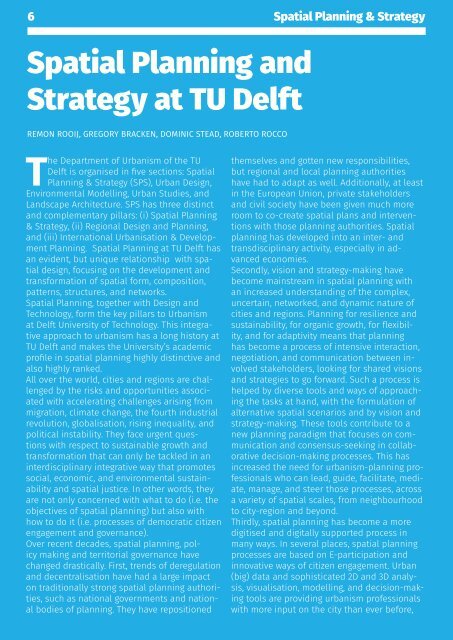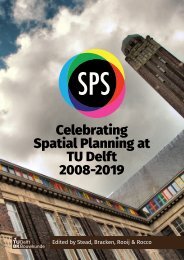*Celebrating Spatial Planning at TU Delft: 2008-2019. Edited by Stead, Bracken, Rooij & Rocco
This is a summary of the achievements of the session Spatial Planning & Strategy of the Department of Urbanism, Faculty of Architecture and the Built Environment, TU Delft, led by Professor Vincent Nadin between 2008 and 2019.
This is a summary of the achievements of the session Spatial Planning & Strategy of the Department of Urbanism, Faculty of Architecture and the Built Environment, TU Delft, led by Professor Vincent Nadin between 2008 and 2019.
You also want an ePaper? Increase the reach of your titles
YUMPU automatically turns print PDFs into web optimized ePapers that Google loves.
6 <strong>Sp<strong>at</strong>ial</strong> <strong>Planning</strong> & Str<strong>at</strong>egy<br />
<strong>Sp<strong>at</strong>ial</strong> <strong>Planning</strong> and<br />
Str<strong>at</strong>egy <strong>at</strong> <strong>TU</strong> <strong>Delft</strong><br />
REMON ROOIJ, GREGORY BRACKEN, DOMINIC STEAD, ROBERTO ROCCO<br />
The Department of Urbanism of the <strong>TU</strong><br />
<strong>Delft</strong> is organised in five sections: <strong>Sp<strong>at</strong>ial</strong><br />
<strong>Planning</strong> & Str<strong>at</strong>egy (SPS), Urban Design,<br />
Environmental Modelling, Urban Studies, and<br />
Landscape Architecture. SPS has three distinct<br />
and complementary pillars: (i) <strong>Sp<strong>at</strong>ial</strong> <strong>Planning</strong><br />
& Str<strong>at</strong>egy, (ii) Regional Design and <strong>Planning</strong>,<br />
and (iii) Intern<strong>at</strong>ional Urbanis<strong>at</strong>ion & Development<br />
<strong>Planning</strong>. <strong>Sp<strong>at</strong>ial</strong> <strong>Planning</strong> <strong>at</strong> <strong>TU</strong> <strong>Delft</strong> has<br />
an evident, but unique rel<strong>at</strong>ionship with sp<strong>at</strong>ial<br />
design, focusing on the development and<br />
transform<strong>at</strong>ion of sp<strong>at</strong>ial form, composition,<br />
p<strong>at</strong>terns, structures, and networks.<br />
<strong>Sp<strong>at</strong>ial</strong> <strong>Planning</strong>, together with Design and<br />
Technology, form the key pillars to Urbanism<br />
<strong>at</strong> <strong>Delft</strong> University of Technology. This integr<strong>at</strong>ive<br />
approach to urbanism has a long history <strong>at</strong><br />
<strong>TU</strong> <strong>Delft</strong> and makes the University’s academic<br />
profile in sp<strong>at</strong>ial planning highly distinctive and<br />
also highly ranked.<br />
All over the world, cities and regions are challenged<br />
<strong>by</strong> the risks and opportunities associ<strong>at</strong>ed<br />
with acceler<strong>at</strong>ing challenges arising from<br />
migr<strong>at</strong>ion, clim<strong>at</strong>e change, the fourth industrial<br />
revolution, globalis<strong>at</strong>ion, rising inequality, and<br />
political instability. They face urgent questions<br />
with respect to sustainable growth and<br />
transform<strong>at</strong>ion th<strong>at</strong> can only be tackled in an<br />
interdisciplinary integr<strong>at</strong>ive way th<strong>at</strong> promotes<br />
social, economic, and environmental sustainability<br />
and sp<strong>at</strong>ial justice. In other words, they<br />
are not only concerned with wh<strong>at</strong> to do (i.e. the<br />
objectives of sp<strong>at</strong>ial planning) but also with<br />
how to do it (i.e. processes of democr<strong>at</strong>ic citizen<br />
engagement and governance).<br />
Over recent decades, sp<strong>at</strong>ial planning, policy<br />
making and territorial governance have<br />
changed drastically. First, trends of deregul<strong>at</strong>ion<br />
and decentralis<strong>at</strong>ion have had a large impact<br />
on traditionally strong sp<strong>at</strong>ial planning authorities,<br />
such as n<strong>at</strong>ional governments and n<strong>at</strong>ional<br />
bodies of planning. They have repositioned<br />
themselves and gotten new responsibilities,<br />
but regional and local planning authorities<br />
have had to adapt as well. Additionally, <strong>at</strong> least<br />
in the European Union, priv<strong>at</strong>e stakeholders<br />
and civil society have been given much more<br />
room to co-cre<strong>at</strong>e sp<strong>at</strong>ial plans and interventions<br />
with those planning authorities. <strong>Sp<strong>at</strong>ial</strong><br />
planning has developed into an inter- and<br />
transdisciplinary activity, especially in advanced<br />
economies.<br />
Secondly, vision and str<strong>at</strong>egy-making have<br />
become mainstream in sp<strong>at</strong>ial planning with<br />
an increased understanding of the complex,<br />
uncertain, networked, and dynamic n<strong>at</strong>ure of<br />
cities and regions. <strong>Planning</strong> for resilience and<br />
sustainability, for organic growth, for flexibility,<br />
and for adaptivity means th<strong>at</strong> planning<br />
has become a process of intensive interaction,<br />
negoti<strong>at</strong>ion, and communic<strong>at</strong>ion between involved<br />
stakeholders, looking for shared visions<br />
and str<strong>at</strong>egies to go forward. Such a process is<br />
helped <strong>by</strong> diverse tools and ways of approaching<br />
the tasks <strong>at</strong> hand, with the formul<strong>at</strong>ion of<br />
altern<strong>at</strong>ive sp<strong>at</strong>ial scenarios and <strong>by</strong> vision and<br />
str<strong>at</strong>egy-making. These tools contribute to a<br />
new planning paradigm th<strong>at</strong> focuses on communic<strong>at</strong>ion<br />
and consensus-seeking in collabor<strong>at</strong>ive<br />
decision-making processes. This has<br />
increased the need for urbanism-planning professionals<br />
who can lead, guide, facilit<strong>at</strong>e, medi<strong>at</strong>e,<br />
manage, and steer those processes, across<br />
a variety of sp<strong>at</strong>ial scales, from neighbourhood<br />
to city-region and beyond.<br />
Thirdly, sp<strong>at</strong>ial planning has become a more<br />
digitised and digitally supported process in<br />
many ways. In several places, sp<strong>at</strong>ial planning<br />
processes are based on E-particip<strong>at</strong>ion and<br />
innov<strong>at</strong>ive ways of citizen engagement. Urban<br />
(big) d<strong>at</strong>a and sophistic<strong>at</strong>ed 2D and 3D analysis,<br />
visualis<strong>at</strong>ion, modelling, and decision-making<br />
tools are providing urbanism professionals<br />
with more input on the city than ever before,




